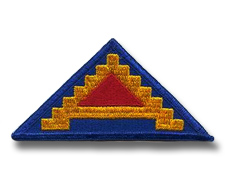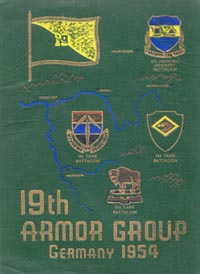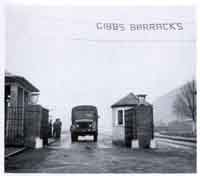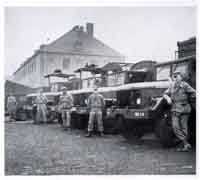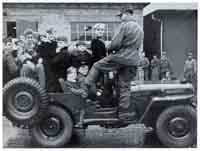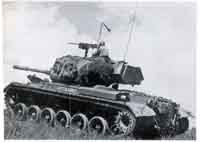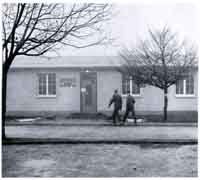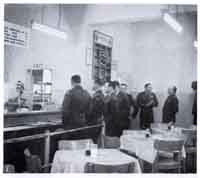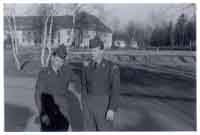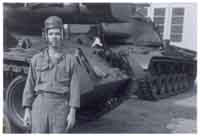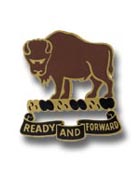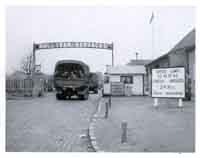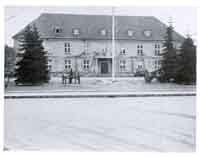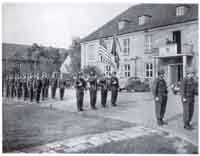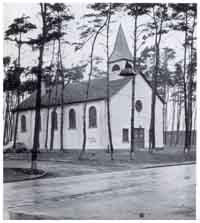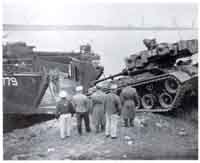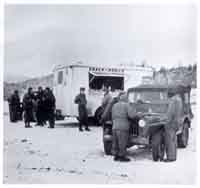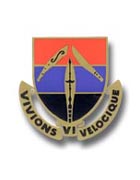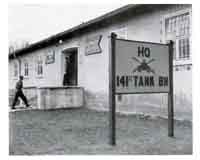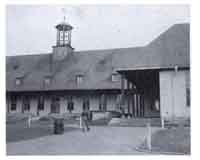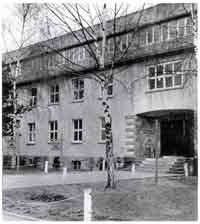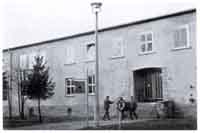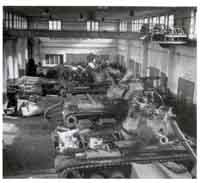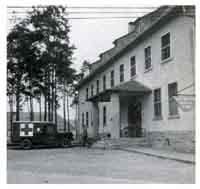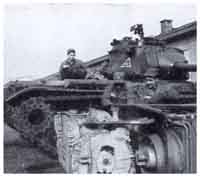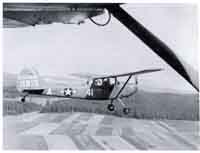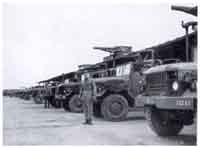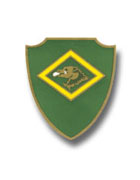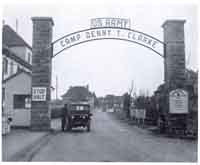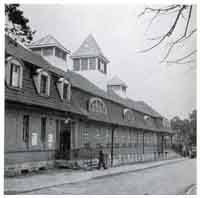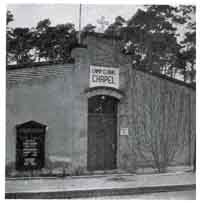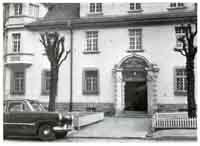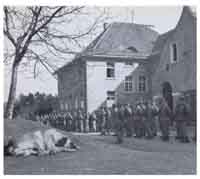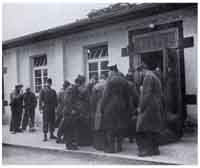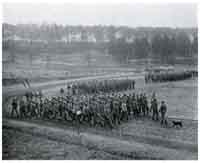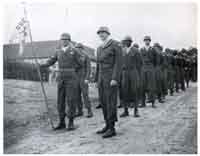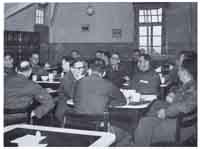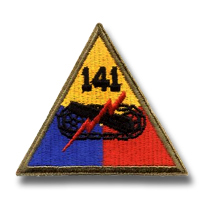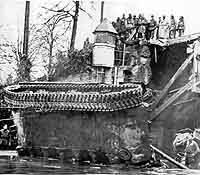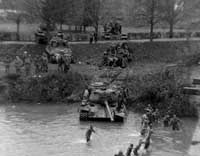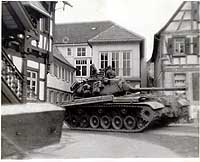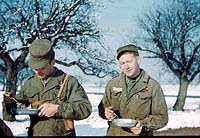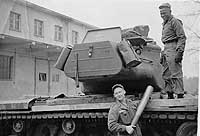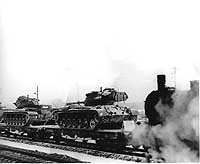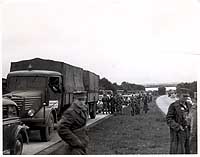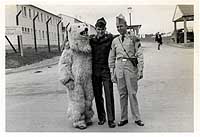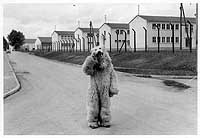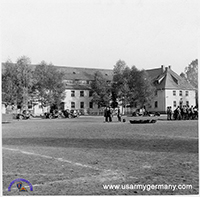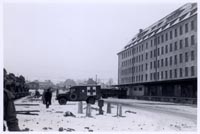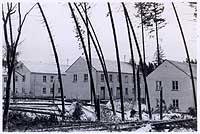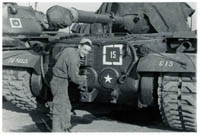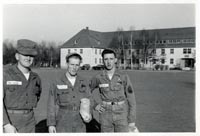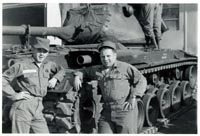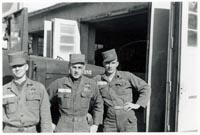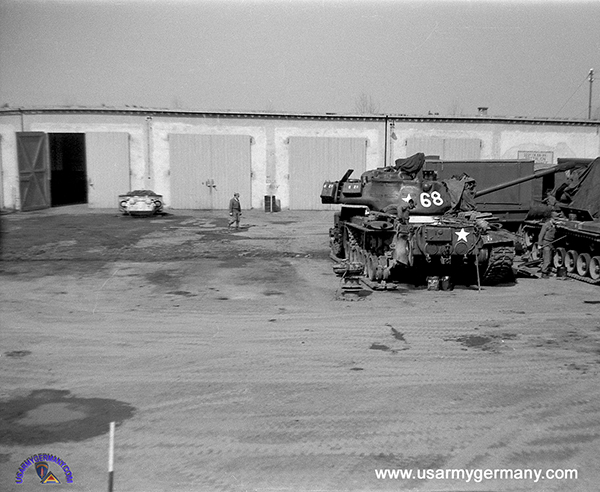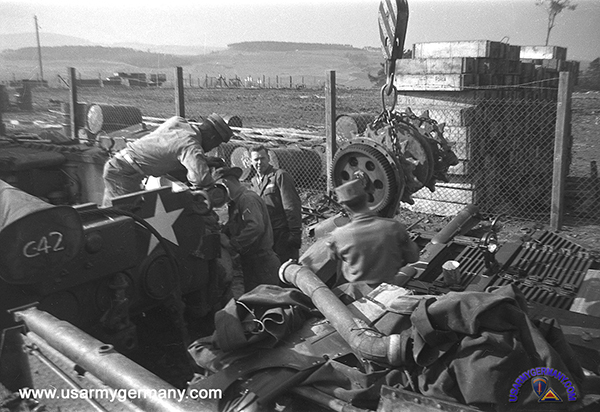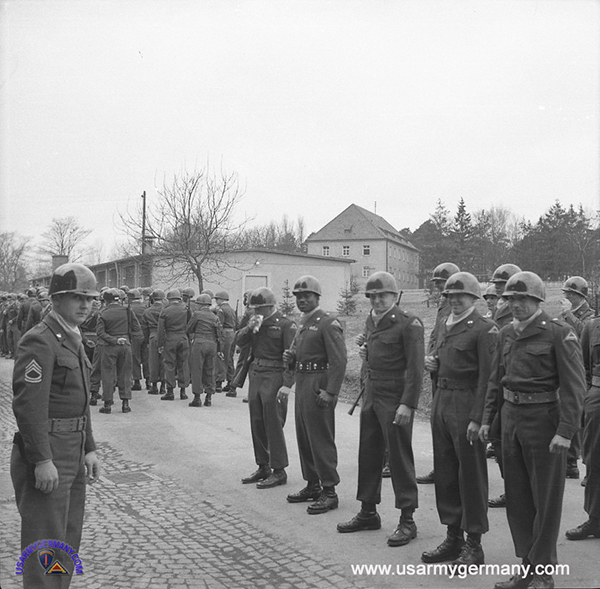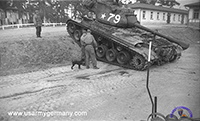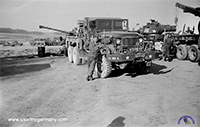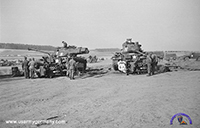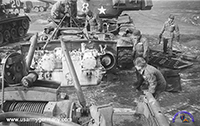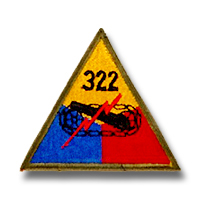| If you do
NOT see the Table of Contents frame to the left of this page, then
Click here to open 'USArmyGermany' frameset |
|||||||||||||||||||||||||||||||
19th Armor Group |
|||||||||||||||||||||||||||||||
|
|||||||||||||||||||||||||||||||
|
|
|||||||||||||||||||||||||||||||
 |
|||||||||||||||||||||||||||||||
| Group History | |||||||||||||||||||||||||||||||
| 1953 - 1955 | |||||||||||||||||||||||||||||||
| (Source: 19th Armor Group, Germany 1954.) | |||||||||||||||||||||||||||||||
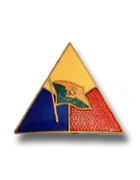 19th Armor Group DUI
19th Armor Group DUIThe 19th Cavalry Reconnaissance Squadron, predecessor of Headquarters and Headquarters Company, 19th Armored Cavalry Group, served in the European Theater during World War II. The 19th was attached to the 16th Cavalry Group and served under Gen Patton's Third Army. On 12 April 1945, the long-standing attachment to the 16th Cavalry Group was severed, and the 19th was ordered to Birkenfeld and attached to XXIII Corps. As a mobile reserve for the corps, the Squadron was given a diversity of missions, from rounding up displaced persons, raiding coal mines in search of high explosives, and maintaining prohibited zones, to checking credentials of civilians attempting to cross the zone and the prevention of food smuggling activities. After VE-Day, the unit was categorized for deployment directly to the Pacific to fight Japan, and on 22 June 1945 prepared to move to the Arles Staging Area near Marseille, France. Group Headquarters (the 16th Cav Gp), meanwhile had received orders to be stationed in Berlin. While aboard the USS General W. Goethals, an Army transport bound for the Lingayen Gulf, VJ-Day was announced on 15 August 1945 before the vessel got under way. One day after the General W. Goethals passed the Rock of Gibraltar, the destination of the ship was changed to the Port of Boston. On 10 November 1945, the Squadron was inactivated at Fort Riley, Kansas, almost two years from the date of its activation. After seven years in this status, the unit was redesignated as Headquarters and Headquarters Company, 19th Armored Cavalry Group, and reactivated at Frankfurt, Germany, on 2 January 1953 under the temporary command of Lt Col Dan S. McMillan. Col Charles E. Brown joined the Group and assumed command on 15 March 1954. The Group Headquarters is located at Gibbs Barracks, Frankfurt, which is in the general area it served during World War II. (Webmaster Note: the 19th Armd Cav Gp was redesignated as the 19th Armor Group on 1 October 1953.) Units of the 19th Armor Group include the following: |
|||||||||||||||||||||||||||||||
|
|||||||||||||||||||||||||||||||
| The 19th Armor Group and its attached units are a part of the Seventh Army and operate directly under V Corps to form an important link in the NATO Army. | |||||||||||||||||||||||||||||||
| (Source: Email from Stan Polny) | |||||||||||||||||||||||||||||||
| I served with the 19th A/C from it activation till July 1953. According to James Sawicik's Cavalry Regiments of the US Army, Hq & HQ C, 19th A/C Recon Bn was re-designated 1 Jul 55 as Hq & Hq Co, 4th Armor Grp.
I served in the S-4 section, as the Gp supply sergeant. The section consisted on 2 men, the S-4, a captain, also was the S-4 of the 24th and me, at the time an SFC, although the position called for a Master Sergeant. At that time, a number of men were being rotated to Europe from Korea to finish out their enlistments. We had an influx of first 3 graders, including M/Sgts, so I never did get my promotion. The Hqs was located in Gibbs barracks which was located just across from the US Army Hospital (97th Gen Hosp) The bulk of the EM, if not all, came from the 24th Constabulary Sq, which was inactivated 15 Dec 53. A good number of the officers also came from the 24th, including Col McMillan, who was the last CO of the 24th. A Maj Blake, also of the 24th, served as Exec while McMillan served as temporary CO. I believe your date of Col Brown's assumption of command of the 19th is incorrect. It should be in 1953 not 1954. I left the 19th in Jul and Col Brown was already in command. At that time, only the 3 tank battalions were under the 19th. The battalions were supposed to be heavy tank battalions (M60s) but at that time I believe the M60 was not even on the drawing boards let alone in the army inventory. We had M47s. The DUI of the 373d, also a former Constabulary unit, was the blazon read contained the colors blue and orange - the blue shield with the Constabulary colors golden orange and black on the fess. The 373d was originally an old black EM outfit, with white officers. I have a copy of the orders that transferred the men of the 24th to the 19th. |
|||||||||||||||||||||||||||||||
| (Source: Email from Steven A. Hester, Sr.) | |||||||||||||||||||||||||||||||
| 141st Tank Battalion was inactivated on January 17, 1955 and was reflagged as the 899th Tank Battalion. 899th Tank Battalion was activated on January 17, 1955 when it was organized by reflag of the 141st Tank Battalion. 322nd Tank Battalion was inactivated on December 12, 1954 and was reflagged as the 826th Tank Battalion. 826th Tank Battalion was activated December 17, 1954 and organized by reflag of the 322nd Tank Battalion. These dates are found in “Tank Battalions of the US Army” by James A. Sawicki, copyright 1983 and verified by the Army and USAREUR station lists and other collaborative information from my personal research and files. I have nearly 30 years experience with unit histories, lineages and such matters. I come at my results from an understanding of the conditions which underlay all the turbulent events involving units and the Army as a whole. |
|||||||||||||||||||||||||||||||
| Webmaster
Note: the 19th Armd Cav Gp was inactivated at Frankfurt on 1 July
1955. The Seventh Army troop list from 30 June 1956 indicates that there is a 4th Armor Group assigned to the Seventh Army with attachment to V Corps. Other sources indicate that the 4th is stationed at Frankfurt at this time. Also, my records indicate that the 4th Reconnaissance Battalion (a unit that had been serving as part of the US occupation forces in Austria) was redesignated as Headquarters Company, 4th Armor Group and activated in Germany on 1 July 1955. My assumption, at this point, is that the 19th Armor Group was replaced by the 4th Armor Group upon inactivation of the 19th at Frankfurt in July 1955. If anybody has additional information on the history or organization of the 4th Armor Group, please contact me |
|||||||||||||||||||||||||||||||
|
|
|||||||||||||||||||||||||||||||
| Yearbook 1954 | |||||||||||||||||||||||||||||||
| (Source: 19th Armor Group Germany 1954, Yearbook) | |||||||||||||||||||||||||||||||
|
|||||||||||||||||||||||||||||||
|
|||||||||||||||||||||||||||||||
| The 510th was
alerted for overseas movement in March 1952. Maj James M. McGuire
joined the Battalion and assumed command on 21 April 1952, remaining
in command until 23 May 1952. At that time, Lt Col William L. Boylston
assumed command and Maj McGuire became the executive officer. Sixteen days after boarding the USNS General Horace W. Greeley on 26 July 1952, the Battalion arrived in Germany. On 10 October 1952, the Battalion moved into Sullivan Barracks, Mannheim. Since that time, training has been integrated with field work at the various tank training areas throughout the American and French sectors of Germany. (Webmaster Note: the 510th Tank Battalion was inactivated on 1 May 1958 in Germany.) |
|||||||||||||||||||||||||||||||
|
|||||||||||||||||||||||||||||||
|
|
|||||||||||||||||||||||||||||||
|
|||||||||||||||||||||||||||||||
| As training of
the 141st progressed, the men underwent advance unit instruction at
Camp Irwin, the Tank Training Center in the Mojave Desert, California.
Many officers and enlisted men were sent to combat in Korea during
this period. On 25 July 1952 the Battalion left New Orleans aboard the USS General Greeley, and arrived at Bremerhaven, Germany, on 9 August 1952, becoming Wyoming's contribution to the NATO organization. Throughout the period from May 1947 to November 1953, the 141st Tank Battalion was commanded by Lt Col Louis A. Hansen. Lt Col John J. Kelly arrived from Headquarters 4th Army, Fort Sam Houston, Texas, to take command on 1 November 1953. |
|||||||||||||||||||||||||||||||
|
|||||||||||||||||||||||||||||||
|
|
|||||||||||||||||||||||||||||||
| 1955 | |||||||||||||||||||||||||||||||
| (Source: STARS & STRIPES, Jan 26 1955) | |||||||||||||||||||||||||||||||
| On January 24 1955, the 141st Tank Bn reverted back to National Guard status and was redesignated as the 899th Tank Bn in a ceremony held at Fliegerhorst Kaserne. | |||||||||||||||||||||||||||||||
|
|||||||||||||||||||||||||||||||
| Reserve
officers called into service for extended active duty joined
the 322nd, brought it up to near-strength in officer personnel
by November 1950. The remaining part of 1950 was spent in individual
and small-unit training with the Second Armored Division and
the 306th Armored Cavalry Group. Enlisted personnel increased
in January 1951 as the Draft Act began functioning again. Men
from all over the United States joined the Razorbacks to contribute
much to the efficiency of the Battalion. The 322nd left the home of Cow House Creek (Fort Hood) on 25 March 1951 for Camp Polk, Louisiana, and further training. Platoon and company tests were taken and passed with high commendations during the spring of that year and in July, after a three-day stretch of hard work and little sleep, the men of the 322nd passed the AFF battalion test. The next major move for the Arkansas Battalion came on 25 October 1951 when it moved to Camp Irwin, California, for training in the Armored Combat Training Area. With almost unlimited use of tank armament, the Battalion learned the capabilities of its weapons. From the California Mojave desert, the Razorbacks journeyed back to Camp Polk, Louisiana, in December 1951. A change in command resulted in Lt. Col. Taylor C. T. Hayes in the top spot. Many of the Battalion's "old timers" were released from active duty and their places were filled with men of experience from Fort Hood, Camp Polk, Camp Chaffee, Fort Bliss, Fort Sheridan, and others. The alert for shipment overseas came April 1952. Officers and men worked night and day to prepare the unit. Lt. Col. William W. West III assumed command, replacing Lt. Col. Hayes. After weeks of assiduous preparation, the 322nd joined the 141st Tank Battalion, the 510th Tank Battalion, and two Air Force units aboard the USAT A.W. Greeley, headed for Bremerhaven, Germany. The 3000 mile trip to Camp Denny T. Clarke at Hammelburg was over 11 August 1952. Shortly after arrival, the Battalion received and processed new equipment, including M-47 tanks, eagerly accepted by the tankers. Early in October of that year, the Battalion crests arrived -- Green shield with an Arkansas Razorback hog head superimposed. Commonly referred to as "Old Snort," the crest has done much to create organizational spirit. Also in October the 322nd was attached to the 18th Infantry Regiment for Exercise Bellhook. Commanders of the 18th praised highly the 322nd and expressed a desire to work with the unit on other maneuvers. In 1953 came Vilseck, Battalion test at Grafenwohr, the IG, CMI, Exercises Harvest Moon and Power Play. On 18 September 1953 the Battalion celebrated organizational day with a parade, ball games, and parties. January 1954 brought another IG inspection and it was Vilsek again in February 1954 for tank-infantry training. Today the 322nd Tank Battalion stands as a superior force. Its morale and spirit are high; its men competent. It takes its place with other units of the Seventh Army to guard against aggression. |
|||||||||||||||||||||||||||||||
|
|||||||||||||||||||||||||||||||
|
|
|||||||||||||||||||||||||||||||
| 1954 | |||||||||||||||||||||||||||||||
| (Source: STARS & STRIPES, Dec 22 1954) | |||||||||||||||||||||||||||||||
| In late December 1954, the 322nd Tank Bn reverted back to (Arkansas) National Guard status and was redesignated as the 826th Tank Bn in a ceremony held at Camp Clarke, Hammelburg. (During the same ceremony, the 631st AFA Bn, also stationed at Camp Clarke, was redesignated as the 290th AFA Bn.) |
|||||||||||||||||||||||||||||||
| 141st Tank Bn | |||||||||||||||||||||||||||||||
| (Source: Email from Bob Termuende who served with the 141st Tank Bn from early 1952 to March 1953) | |||||||||||||||||||||||||||||||
|
|||||||||||||||||||||||||||||||
| One more bit of reminiscing: During the winter of 52/53 the
141st was integrated. 10 percent of the Battalion was transferred
to other outfits and was replaced by colored (as they were known
then) troops. The exchange took place in one day and was trouble
free except for a brief hassle at the EM Club one night which
may have been caused by German beer rather than race differences. A couple of times that winter the Russians carried out maneuvres on the Czechoslovakian/German border. When that occurred, the unit would go the motor pool (often in the middle of the night), fire up their tanks, drive them to the rail depot and load them on flat cars. The train would take them past Nuremberg to the Czech border where they would carry out maneuvres for a few days. |
|||||||||||||||||||||||||||||||
|
|||||||||||||||||||||||||||||||
|
|
|||||||||||||||||||||||||||||||
| (Source: Photo album from an unknown member of the 141st Tank Bn, 1952-53) | |||||||||||||||||||||||||||||||
|
|||||||||||||||||||||||||||||||
| (Source: Photo album from an another unknown member of the 141st Tank Bn, 1952-53) | |||||||||||||||||||||||||||||||
|
|||||||||||||||||||||||||||||||
|
|
|||||||||||||||||||||||||||||||
| 322nd Tank Bn | |||||||||||||||||||||||||||||||
|
|||||||||||||||||||||||||||||||
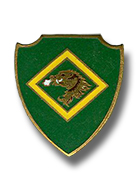 322nd Heavy Tank Battalion DUI 322nd Heavy Tank Battalion DUI |
|||||||||||||||||||||||||||||||
| (Source: Email from Donald E. Bohanan) | |||||||||||||||||||||||||||||||
|
|||||||||||||||||||||||||||||||
| It was in Sept of that year that we went on a NATO maneuver entitled "Indian Summer". (I am not positive about that name but I think that I am correct) I was the last "Free Maneuver" that NATO". We tore up a lot of property with those tanks. I think it was the next year, 1955, that the 6th Artillery, who were also stationed at Hammelburg, moved out. Then the nucleus of the new German Army moved on post with us. They were training the new NCO's and Officers for the new German Army. We were told that we were the first American unit that was ever stationed on the same post with the Germans. It was about this time that we moved to Conn Barracks, Schweinfurt. Then later we moved to Fort Benning, Georgia. I hope some of this helps. |
|||||||||||||||||||||||||||||||
| Related Links: |
|||||||||||||||||||||||||||||||
